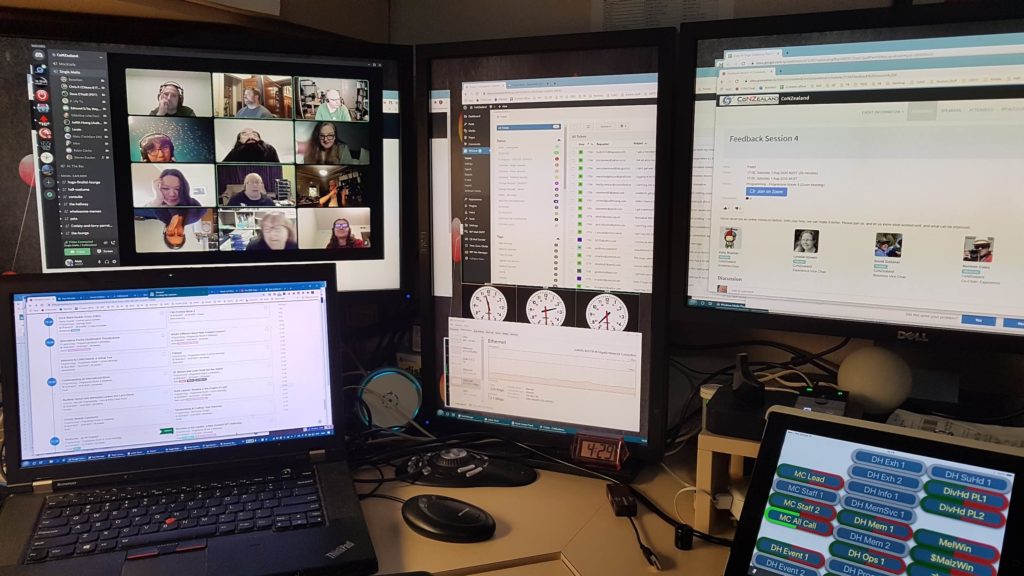New Zealand
7 Oct 2020
CoNZealand 2020 World Science Fiction Convention goes virtual

Subscribe to CX E-News
When the Covid-19 pandemic began to go global, the organisers of CoNZealand, the 78th World Science Fiction Convention, faced a difficult decision
As the world went into lockdown in March, the 2020 event scheduled for late July in Wellington was forced to consider cancellation. With its proud all-volunteer tradition and can-do attitude, the team searched for an alternative. That alternative was centred around the RTS VLink virtual intercom solution supplied by Magna Systems & Engineering.
A lifelong science fiction fan and freelance broadcast engineer based in Sydney, Australia, John Maizels catalogued the requirements, searching for affordable, effective tools with which to address them.
Using free, publicly available tools like Zoom conferencing, Discord chat rooms, and streaming video from Fantasy Network, the CoNZealand team decided to move the entire five-day event online, creating a virtual convention.
The challenge was finding a way to manage it all. “As a broadcaster, it was blindingly obvious that the key to operating as a team when you can’t see anybody is good communications,” says Maizels.
“That meant finding an effective virtual intercom system.”
Maizels consulted with the Asia-Pacific broadcast technology specialists at Magna Systems & Engineering. Magna was already heavily involved in helping clients cope with virtualised broadcast events and socially distanced live sports.
“When John asked us about virtual intercoms, we could confirm that RTS VLink is the best online comms system on the market,” says Lucas Böhm, product manager at Magna Group Australia.
“It’s perfect for global applications because it’s platform agnostic and basically infinitely scalable. It’s a very powerful tool.”
Looking at its flexibility and especially the fact that there is no limit to the number of users, VLink was quickly adopted. RTS and CoNZealand agreed on a 30-seat VLink license, meaning the only limit was a maximum of 30 simultaneous communication streams.
Maizels then developed a concept he called Mission Control, a virtual control room where the core team would have access to a global view of all convention activities.
The key elements were RTS VLink for “backstage” communications, and vMix, a virtual production switcher, to monitor multiple simultaneous video events.
Both applications were “located” in an Amazon Web Services cloud, creating a Mission Control operating independently of all the public-facing elements of CoNZealand.
“Being a product that I had never before used, VLink was slightly daunting, especially given what we were attempting,” notes Maizels. “But since its architecture is essentially that of an RTS digital matrix intercom, it quickly felt very familiar to me, and thus easy both to set up and to explain. That proved to be a huge advantage.”
The next challenge was education. “One of the biggest barriers was that people really believed that simply using their personal device for voice and text would be sufficient communication,” he explains.
“Which is fine – until you have a problem and don’t know what caused it, how to fix it, and who can help. VLink provided the global view and instant access, both partyline and point-to-point, needed to address that.”
During prime hours, virtual CoNZealand offered 15 to 20 simultaneous program events – running multiple live events while preparing the next hour’s schedule.
In addition to panel discussions and presentations via Zoom, there were also virtualised renditions of the exhibit hall, art show, fan tables, parties, bars and cafes.
All had to be monitored. If there were glitches – in audio, in video, in chat – VLink was used to identify the problem and address it.
Another challenge was how best to present the traditional “big tent” events, normally produced live by the Technology Division in a ballroom. These included the opening and closing ceremonies, along with a Masquerade ball.
But the most important events are two science fiction award shows: the Hugo Awards and the Retro Hugos.
For the Hugos, there was no gathering of nominees, no banquet, no physical awards.
But using a combination of pre-taped video segments and live video, the ceremonies were viewed globally in real time, including live announcements of each Hugo Award winner by author George R.R. Martin, live from an empty theatre in Santa Fe, New Mexico.
Like any good intercom system, VLink spent most of the convention quietly enabling countless program events. But it was during the inevitable moments of crisis that VLink really showed its value.
As an example, Maizels points to an Internet issue that hit the area set to host the video feed of the closing ceremonies.
“The Internet at the playout location in Alameda suddenly became very flaky, very unreliable,” says Maizels. “With a quick succession of point-to-point and partyline conversations on VLink, we were able to confirm the issue, then switch the playout operation to another team member, who was in Baltimore.
“Using the partyline on VLink, we could liaison with all parties for the tech handover and tech process. And no one attending the ceremonies online was any the wiser. I have several examples like that, where VLink saved the day.”
magnasys.tv/product/rts
conzealand.nz
CX Magazine – October 2020
LIGHTING | AUDIO | VIDEO | STAGING | INTEGRATION

Entertainment technology news and issues for Australia and New Zealand
– in print and free online www.cxnetwork.com.au
© VCS Creative Publishing
Subscribe
Published monthly since 1991, our famous AV industry magazine is free for download or pay for print. Subscribers also receive CX News, our free weekly email with the latest industry news and jobs.








